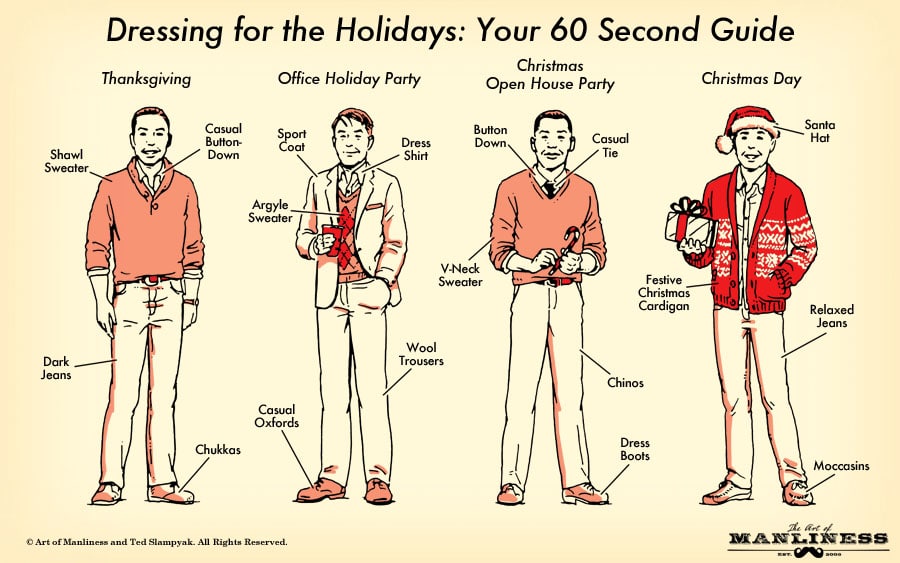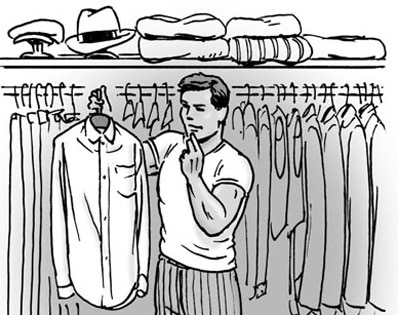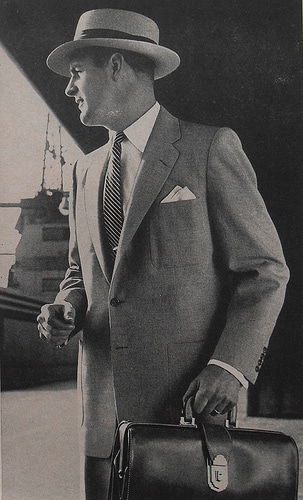With our archives now 3,500+ articles deep, we’ve decided to republish a classic piece each Friday to help our newer readers discover some of the best, evergreen gems from the past. This article was originally published in November 2018.
There’s something very old-fashioned and almost kitschy about the idea of a father teaching his son how to dress like a man.
Part of that, of course, is because a lot of fathers these days don’t really know how to dress themselves, so there isn’t much for them to pass along.
For those of you who never had a style mentor in your father, here are all the lessons a really well-dressed dad would have passed along. Better late than never!
1. Style Matters
This is one that’s often not taught explicitly. Instead, fathers reinforce the idea simply by the act of teaching their sons — it’s implied that, because Dad is spending time on this stuff, it must matter.
It’s a good lesson to internalize. Style matters, both as an individual and as a part of a family.
People do judge you based on your appearance. If you believe otherwise, you’re just kidding yourself. You want to be a good person, absolutely — but no matter how good you are, you’re not going to be judged by the quality of your character until people have had a chance to observe it for a while. Until then, they’re going off of appearances.
That makes it crucial for everyone who wants to be taken seriously to present himself well. And fathers who want their sons to do well — and who want their family to be respected — will be sure to pass that lesson along.
2. Individual Pieces of Clothing Can Be Special
The bond between father and son isn’t always intangible. Sometimes, it comes in the form of treasured physical objects passed on from one generation to the next.
The best of these are the “they just don’t make ’em like they used to” pieces from brands that no longer exist, or that changed their manufacturing processes.
You don’t need to have actually received something from your father to enjoy keeping it in good shape and wearing it long after all the others are gone. There’s a thriving culture of restored vintage clothing out there these days.
Some of it is pure economic good sense — if you can spend less money to restore a better piece of clothing than you would buying something similar and less durable new, why wouldn’t you? But some of it also stems from the pride and emotional attachment that really caring for a favored item gives.
Don’t be afraid to be the guy with the battered old favorite, whatever it is. Know when to wear it and when not to, of course (something with obvious repair work and patching isn’t exactly business attire), but don’t be afraid to let those sentimental attachments build.
3. Dressing Well Is Easy — If You Have a System
Dads are supposed to show you the best way to do things, right?
That relies on your dad actually knowing the best way to do things. Sometimes they do and sometimes — as we discover when we grow older — they don’t.
But here’s the easy way to dress well that all fathers should teach their sons: have a system. Reduce obstacles. Make it the path of least resistance to look good.
It doesn’t take much to make dressing well your easiest option. Throw out the stuff that doesn’t fit or that looks sloppy. Then buy new clothes as needed, with an eye toward interchangeability. You want every new item you bring home to go well with at least some of the items already in your closet. If you need even more structure than that, you can make a list of which pieces go well together, or even plan your outfits day by day.
Keep your wardrobe ready-to-wear too. Iron your shirts right after you launder them, so you can just grab one off the hangar whenever you need to. Place items like a clothing brush and your shoeshine kit close to the clothing you use them with — you’re much more likely to say, “Oh, hey, time to shine the shoes,” if you’re looking right at the polish and brushes every time you put your shoes away.
It’s not about making yourself do something you want. It’s about making what you want the easiest thing to do.
4. Buy Quality
There are a couple of investments you can make when clothes shopping.
You can spend money on a brand name. You can spend money on a fashionable design. Or you can spend money on the physical quality of the piece — how it fits, what it’s made of, and how well-constructed the finished garment is.
A responsible father will always tell his son to prioritize quality. Everything else is secondary.
This is aesthetic as well as practical. A better-made garment doesn’t just last longer (getting you more value for your dollar) — it also looks better.
Don’t believe it? Visit somewhere with a wide range of clothes. A big menswear store like Jos. A. Bank or Men’s Wearhouse will work. They don’t have the highest quality suits, but they’ll have “Executive Collections” or something similarly-named that are quite a bit more expensive than the entry-level clothing.
Look at the difference between the high end and the low end. Just hanging on the rack, you can already see a pronounced improvement in the drape, the hand-feel, and the luster of the more expensive fabrics.
That’s what you want to be spending money on. You want clothes that last, clothes that don’t look cheap and flimsy, and — of course — clothes that fit. If that means spending a little more for better fabrics and stores that do in-house adjustments, that’s a small price to pay.
And it’s money much better spent than shelling out for a brand name or a fashion trend! Trust your father — and us — on that one.
5. Take a Good Deal When You See One
There’s a difference between a sale and a bargain.
If you don’t know the difference, blame your dad. He should have taught you.
Sales are ubiquitous. They’re everywhere, and most of the time they’re fake. Retailers mark most of their items with two prices: a “standard” price that they never planned to sell the item at, and a “sale” price that they slapped on the tag as soon as it hit their shipping counter. The first number is just a fictional comparison point designed to make the second number seem like a special deal, instead of the default price that it really is.
So ignore “sale prices.” But every once in a while, a real deal does come along, and that’s when you shouldn’t be afraid to strike — even if it means spending a little more than you normally would.
Here’s how you tell if something is a real bargain: if it’s an item you already wanted, and it costs less than you’d expected to pay if-and-when you finally shelled out for one, it’s a bargain. If you didn’t want it, or it’s more expensive than your expectations, it’s probably not a great deal.
Finding those perfect opportunities is rare. Unless you’re a dedicated bargain-hunter, you’ll only see them once in a while. But when you do, go ahead and take them, even if it means spending a little more than you’d planned that month. A really good investment is always worth making.
6. Take Care of What You Own
Repairs are cheaper than replacement.
There’s a half-life on that equation, of course. We’ve all had cars hit the point where fixing them would cost more than the remaining lifespan of the car is worth.
But clothes, happily, don’t usually run into the same kind of massive expenses cars do. Even a major repair job is unlikely to run much over $100, unless the material or construction is something incredibly uncommon.
And while that’s not a negligible sum, it’s also less than a brand-new suit (or even a nice-quality jacket) costs.
So take a lesson from Dad, or from us, and maintain the things you have rather than replacing them with things you don’t have. Shoes, clothing, whatever — get it cleaned when you need to, do the little maintenance tasks that help stave off more expensive repairs, and when things get damaged, get them fixed.
This is good, solid, practical advice. It makes sense for your budget. But it’s also a point of pride. If you can’t take responsibility for your own clothing, how are you going to take responsibility for bigger, more important things in life?
Show a little self-reliance — the kind that would make Dad proud — and keep your clothing in shape and in the wardrobe for as long as the material can hold out.
7. Build a Relationship With Shops and Tailors
Small, locally-owned businesses have had a tough time of it all over, but the self-owned tailor’s shop is still hanging in there, as a concept, at least.
Make it part of your routine as a well-dressed man to rely on independent businessmen as much as possible. Avoid the big-box chain stores. They’re not good for anything, except low prices, and even then you’re usually getting something so cheaply-made that you end up losing money on replacement costs within a year or two.
Instead, shop less frequently, spend a little more, and try to both buy your clothing and have it altered by people you can get to know personally. You want places that have “lifers” — owners and employees who are dedicated to the business itself, not to a paycheck.
There’s an ethical component to that advice, but there’s also a practical one. Small, independent businesses are much more open to discussion, negotiation, and customization than big chain stores. At a chain store there are fixed policies that no one has the authority to contradict — they can only do what management says they can do.
Men and women who own their own businesses are free to work with the customer as much as they please. If you’re at all interested in building a customized wardrobe, whether it’s hand-tailored or not, it’s worth doing as much of your shopping as possible at places where you can build a flexible, personalized relationship.
8. It’s Better to Be Looked Over than Overlooked
There’s nothing wrong with being the best-dressed man in the room.
The concept of “overdressed” should be used very sparingly. If you’re actively making people uncomfortable (wearing an expensive business suit for a photo-op with homeless people, say — something more than one politician has done, and been criticized for), then you should think about toning it down. And special event clothing should be saved for special events — don’t wear a tuxedo to work.
But beyond that, there’s no real upper limit to how nice you can look. Feel like wearing a suit and tie during your weekend errands? Go for it. It’s not necessary, but it’s also not wrong.
Taking pride in how you look includes not being shy about dressing well. It doesn’t matter if the other men around you are doing it or not. You’re not responsible for their clothing — but you are responsible for yours.
9. Your Clothes Affect Your Mindset
Most dads don’t get too deep into the psychology, but “look like a winner and you’ll be a winner” is solidly within the realm of parental advice.
It also has the advantage of being true. You really can make yourself more successful by dressing better.
Clothes have what psychologists call a “talisman effect.” We associate them with specific images and ideas, regardless of who wears them.
In one study, participants who were given a white lab coat to wear performed better on scientific reasoning tests than participants in their street clothes — and when the experiment was repeated, but with the coat introduced to participants as an artist’s smock, the difference vanished. The people who believed they were dressed like a scientist became better scientists, and the people who believed they were dressed like an artist didn’t.
Your clothes can have the same effect for you. If you’re working from home and you find yourself wasting time on non-work activities, try dressing up in business clothes at the start of your work day. If you’re angling for a raise or a promotion, start dressing like the people at the level you aspire to. And so on — wear the clothes that represent the mindset you want, rather than the mindset you have. Change will follow.
10. Looking Good Takes Practice
One final piece of fatherly advice: if you want to be good at something, you have to practice, practice, practice.
That holds just as true for dressing well as anything else. No one is born a naturally sharp dresser, and anyone who thinks he was is kidding himself (and probably doing it to excuse some bad fashion choices).
Approach improving your image like you would any other project. Ask around for advice, read expert guides, and indulge in some trial-and-error.
And yes — there will be errors. You’ll make a few poor choices along the line. Maybe that’ll result in owning something you don’t wear much, because it turned out not to work for you, or maybe you’ll have a couple days where you look a little silly.
It’s not the end of the world. You’ll get better at it with practice. And if you stop trying, you won’t get any better.
So try hard, seek the advice you need, and when you fail try again — just like Dad would tell you to.
_________________________________________
Written By Antonio Centeno
Founder, Real Men Real Style
Click here to grab my free ebooks on men’s style








